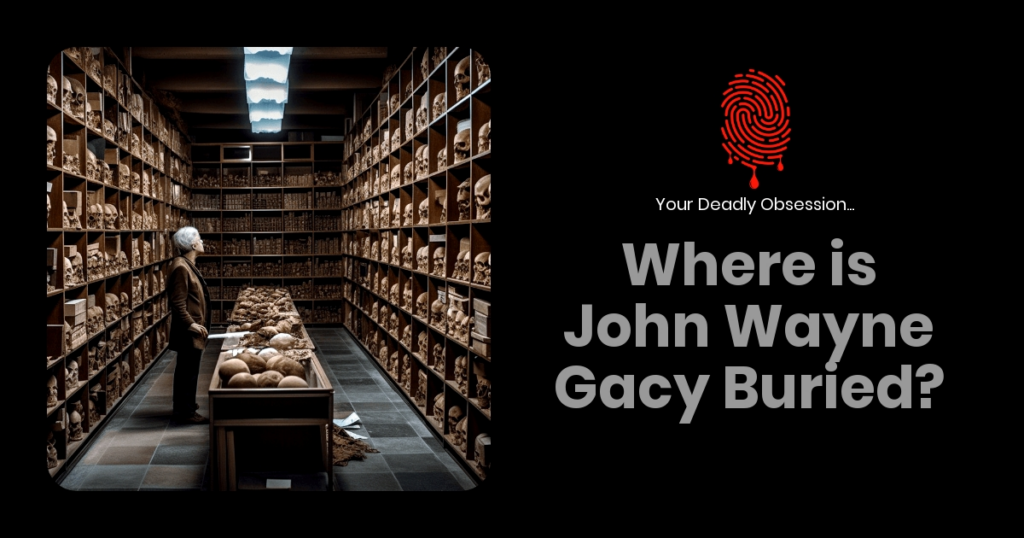When discussing the notorious serial killer John Wayne Gacy, it’s only natural to wonder about his final resting place. Gacy, known as the “Killer Clown,” was convicted of murdering 33 young men and boys between 1972 and 1978, making him one of the deadliest serial killers in history. After his trial, Gacy was executed via lethal injection on May 10, 1994. But where is he buried?

In accordance with his wishes, Gacy’s body was cremated following his execution. Thus, there isn’t a burial site or grave marker to visit in this case. Gacy’s ashes were reportedly given to his sister, and their precise location remains a private matter, known only to the family.
The tragic stories and abominable acts committed by John Wayne Gacy will remain etched in our memories. However, with no grave or burial site to speak of, the focus should remain on remembering the victims and learning from this dark chapter in American history.
The Life of John Wayne Gacy
John Wayne Gacy was born on March 17, 1942, and he grew up in a turbulent household with an abusive alcoholic father. As a teenager, Gacy was plagued by health issues, including a heart condition, which resulted in a life of constant medical treatments.
Gacy showed an interest in community service, becoming involved in various organizations. He later married and had children, setting up a seemingly normal life. In the 1970s, Gacy opened his own construction business and became a highly-regarded community figure. However, there was a dark side to his accomplishments. Gacy developed a fascination with clowns and even created his own character, Pogo the Clown. Unbeknownst to many, he used this persona to lure teenage boys and young men to their deaths.
Gacy’s criminal history began in 1968 with the conviction of sexual assault. Released in 1970, after only 18 months in prison, Gacy returned to Chicago and continued to prey on young men. Between 1972 and 1978, Gacy murdered a minimum of 33 young males, burying most of their bodies beneath his suburban home.
- Early life: March 17, 1942 – 1968
- Criminal history: 1968 – 1978
- Murders: 33+ victims
Authorities finally caught up with Gacy in December 1978 after the disappearance of teenager Robert Piest. Gacy was arrested and charged with over 30 counts of murder. He was convicted in 1980 and subsequently sentenced to death. After spending 14 years on death row, Gacy was executed by lethal injection on May 10, 1994.
Gacy’s story continues to draw attention to this day due to its disturbing nature and the sheer number of victims. His life and crimes have inspired numerous books, documentaries, and films. It’s important for us to remember the tragic fate of Gacy’s victims and work towards preventing such heinous acts in the future.
The Final Resting Place of Gacy
After his execution by lethal injection on May 10, 1994, John Wayne Gacy’s body was cremated instead of being buried. As one of the most notorious serial killers in American history, it’s no surprise that Gacy’s cremation generated some curiosity among the public, especially considering how he managed to elude authorities for years.
Although Gacy’s parents are buried in a Chicago cemetery, it’s unclear what happened to his ashes. Rumors swirl regarding whether they were scattered or stored somewhere, but no one has been able to confirm their final location. Due to the gruesomeness of his crimes and negative publicity surrounding his name, it’s entirely possible that Gacy’s family chose not to disclose the fate of his cremated remains.
Here’s a quick overview of John Wayne Gacy’s life and crimes:
- Born: March 17, 1942
- Died: May 10, 1994
- Number of victims: 33 confirmed
- Methods of murder: Suffocation and strangulation
- Criminal status: Executed by lethal injection
While Gacy’s burial site remains unknown, there are locations related to his life which carry undeniable importance:
- 8213 West Summerdale Avenue in Norwood Park Township, Cook County, Illinois: This was Gacy’s residence where he committed most of his crimes. It was dubbed the “House of Horrors” upon the discovery of the 29 bodies buried in the crawl space beneath the house. The property was demolished in 1979, but a new home was built on the site years later.
- Menard Correctional Center, Chester, Illinois: This prison housed Gacy during much of his incarceration, as he awaited trial and subsequent execution.
As understandable, Gacy’s final resting place remains a subject of speculation among crime and mystery enthusiasts. Despite his criminal legacy, the true location of Gacy’s ashes remains a well-kept secret that adds to the enigma surrounding the infamous serial killer.
Conclusion: Legacy and Controversy
We’ll finish our exploration into John Wayne Gacy’s burial by discussing the legacy and controversy that surround his life and death. As fans of cold cases and crime mysteries, it’s important for us to analyze the lasting impact such a notorious individual has left behind.
In the years following Gacy’s execution, his macabre artwork gained attention and notoriety. Collectors and fans of true crime were drawn to the paintings he created while on death row, depicting scenes from his own twisted imagination. While some view these works as a glimpse into the mind of a serial killer, others argue that selling and collecting his art glorifies a heinous criminal. The debate continues to this day, highlighting the complex emotions surrounding Gacy’s legacy.
The story of John Wayne Gacy also led to significant changes in law enforcement practices. It led to:
- Improved missing person databases and reporting;
- An increase in the use of psychological profiling for investigative purposes;
- Greater cooperation among different jurisdictions to solve crimes.
Moreover, Gacy’s case has become a point of reference in the study of criminal psychology. It continues to be frequently featured in true crime documentaries and books, providing valuable insights to delve deeper into the understanding of how and why such terrible atrocities are committed.
As for Gacy’s final resting place, it remains a secret that we are unlikely to uncover anytime soon. Despite his wishes to be buried at an undisclosed location, controversy and speculation continue to surround his burial. Some theories suggest his body was cremated and the ashes scattered, while others believe his remains were buried in an unmarked grave. Regardless of the truth, the mystery only adds to the dark allure of the John Wayne Gacy story.
In closing, we hope this exploration into the burial of John Wayne Gacy has given you insight into questions that his case has raised about the criminal mind, grave secrets, and the lasting effects of infamous serial killers on society, law enforcement, and true crime aficionados alike.
References:
https://www.britannica.com/biography/John-Wayne-Gacy

Owner & entrepreneur with a passion for murder mystery! Seriously, who doesn’t love murder mystery?
Chris is a proud member of the American Medical Writer’s Association (AMWA), the International Society for Medical Publication Professionals (ISMPP), the National Association of Science Writers (NASW), the Council of Science Editors, the Author’s Guild, and the Editorial Freelance Association (EFA).

